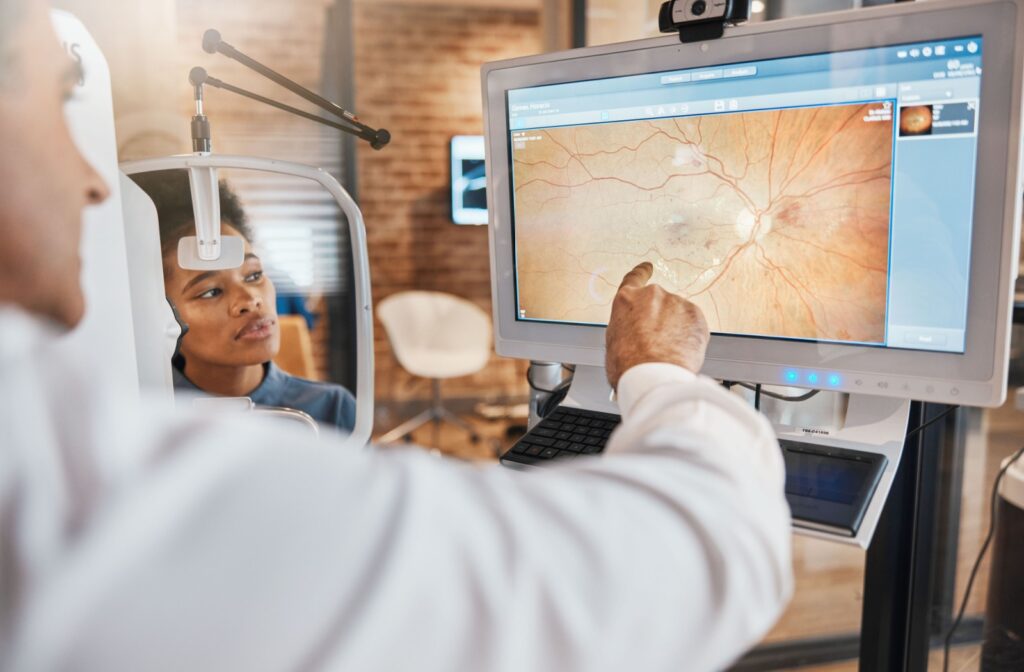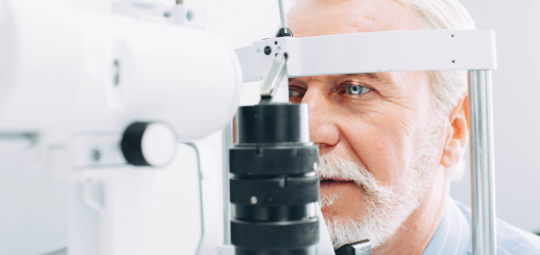Our bodies are an interconnected web, which is why our eyes can offer a glimpse into our overall health by revealing the earliest signs of general conditions like diabetes.
A routine eye exam can detect diabetes by identifying abnormal changes or signs of damage in the retina, optic nerve, and blood vessels. This is done with specialized tools such as ophthalmoscopes, retinal photos, and OCT imaging.
Diabetes & Your Eyes
Diabetes is a chronic health concern that develops when your body doesn’t produce enough insulin, or when it cannot properly use the insulin it produces.
Insulin is a hormone that helps glucose enter your cells so that it can be used as energy. Without effective use of insulin, glucose can build up in your blood, leading to high blood sugar levels over time.
While insulin production isn’t directly linked to our eyes, the intricate network of blood vessels required to nourish our eyes can be sensitive to changes in blood sugar levels. Hence why our vision is greatly affected by diabetic-related changes in the eye.
Unmanaged diabetes significantly increases the risk of developing serious eye conditions, but managing this condition won’t eliminate the risk entirely. A few conditions could develop:
- Diabetic Retinopathy: High blood sugar levels damage blood vessels in the retina. These damaged vessels can leak fluid, bleed, or become blocked, and new, fragile blood vessels may grow abnormally. This is one of the leading causes of vision loss in adults.
- Diabetic Macular Edema: This condition results from advanced diabetic retinopathy. It causes damaged blood vessels to leak fluid into the macula (a structure in the retina), causing it to swell. This affects central vision, reducing one’s ability to see sharp, detailed images.
- Glaucoma: Diabetes doubles the risk of developing glaucoma, a group of eye diseases that damage the optic nerve, often leading to peripheral vision loss. It develops when newly formed blood vessels block the normal flow of fluid out of the eye, increasing eye pressure.
- Retinal Detachment: Scar tissue formed by new blood vessels resulting from diabetic retinopathy can tug on the retina, causing it to detach from the back of the eye. Without prompt treatment, this condition may result in irreversible vision loss.
How Eye Exams Can Detect Diabetes
Routine eye exams don’t just focus on whether patients need glasses or contacts.
These comprehensive visits thoroughly assess your overall health and preserve vision by detecting the onset of eye conditions early, allowing for timely management.
Even when patients aren’t aware of potential problems, optometrists can identify signs and symptoms that could indicate the presence of certain conditions, including early signs of diabetes.
During the health evaluation portion of an eye exam, optometrists focus on the eye’s internal structures, such as the retina, optic nerve, and blood vessels. These structures are extremely sensitive to changes in blood sugar levels.

Signs of diabetes-related complications can include:
- Swelling or microaneurysms in the retinal blood vessels.
- Tiny hemorrhages or spots of bleeding in the retina.
- Leakage of fluid or protein deposits, known as exudates.
- Damage to the blood vessel walls, causing them to narrow or block off.
These signs are often invisible to patients and may occur long before someone experiences any symptoms of diabetes. This is why optometrists rely on specialized tools and techniques to identify these complications. Some of examples of these include:
- Ophthalmoscopy: This tool directs light into the eye to get a clear view of blood vessels in the back of the eye (in the retina) to look for any signs of damage or abnormalities.
- Retinal Photos: A high-resolution camera captures detailed images of the retina and optic nerve. Optometrists analyze these photos to assess the condition of the retina and detect any signs of bleeding, fluid leakage, or narrowed/blocked blood vessels.
- Optical Coherence Tomography (OCT): This imaging technique provides cross-sectional images of the various layers of the retina that can be used to look for any abnormal changes in thickness, swelling, or abnormal fluid accumulation in greater detail.
These symptoms aren’t exclusive to diabetes-related vision changes, but they can indicate unmanaged high sugar levels. To preserve your vision, seek immediate care if you experience:
- Dark spots
- Difficulty focusing
- Fluctuating vision
- Loss of peripheral vision
- Sudden blurry or faded vision
- New floaters or sudden flashes
- Eye pressure or pain
The Diabetic Eye Exam
Everyone, regardless of age or health status is encouraged to have a routine eye exam. However, patients with diabetes require additional care and monitoring.
A diabetic eye exam is a tailored check-up designed to closely monitor diabetic-related changes. These exams establish a baseline for retinal health, serving as a point of comparison for future exams.
Patients with diabetes are encouraged to have at least one annual diabetic eye exam.
This exam differs slightly from a routine eye exam, as it includes a dilation, where specialized eye drops are used to widen (or dilate) the pupils, causing more light to enter the eye. This provides your optometrist with a much better view of the eye’s internal structures, making it easier to look for subtle signs of damage or abnormal change.
Blurry vision and light sensitivity are common side effects of these drops, but will normally subside in a few hours. Still, we recommend bringing a pair of sunglasses and a friend to your appointment to help get you home safely!
Schedule a Visit
Routine eye exams and diabetic eye exams help monitor and detect even subtle signs of diabetes-related changes. Staying on top of these exams plays a key role in preserving vision and overall ocular health. Connect with our team at The Village Eye Care to schedule an appointment for your eye exams.
















